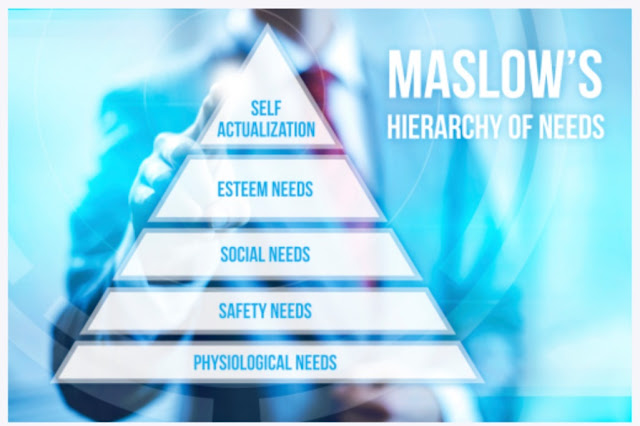Maslow's Need Hierarchy Theory and its Criticism
 |
| Maslow's Hierarchy of Needs |
Maslow's Hierarchy of Needs
Maslow's hierarchy of needs is a theory in psychology that was proposed by Abraham Maslow in his 1943 paper "A Theory of Human Motivation." According to Maslow, human beings have a hierarchy of needs that must be met in order for them to achieve their full potential. These needs are arranged in a pyramid, with the most basic needs at the bottom and the more complex needs at the top.
The five levels of Maslow's hierarchy of needs are:
Physiological needs: These are the most basic needs and include things like food, water, and shelter. These needs are essential for survival and must be met before an individual can move on to the next level of needs.
Safety needs: Once an individual's physiological needs are met, they will begin to focus on their safety and security. This includes things like personal safety, financial security, and the protection of loved ones.
Social needs: After safety needs are met, an individual will begin to focus on their social connections and relationships. This includes the need for friendship, intimacy, and a sense of belonging to a community or group.
Esteem needs: At this level, an individual will focus on their self-esteem and self-worth. This includes the need for self-respect, recognition, and accomplishment.
Self-actualization needs: This is the highest level of needs and relates to personal growth and the desire to fulfill one's potential. This includes the desire to become the best version of oneself and to achieve one's goals and dreams.
According to Maslow, as people progress through the hierarchy and have their basic needs met, they become motivated to fulfill higher level needs. For example, if an individual is hungry, they will be motivated to find food. Once they have enough food to satisfy their hunger, they will move on to the next level of needs, which may be safety and security. This process continues until the individual reaches the top of the hierarchy, at which point they may become motivated to achieve their full potential and self-actualize.
However, it's important to note that this hierarchy is not a strict set of rules, and the needs of individuals may differ. Some people may place a higher priority on social connections and relationships, while others may prioritize personal growth and self-actualization. Additionally, Maslow's hierarchy is not a fixed model, and an individual may move back and forth between different levels of needs at different times in their life.
One of the key ideas behind Maslow's hierarchy of needs is that lower level needs must be met before higher level needs can be addressed. For example, if an individual is struggling to meet their basic physiological needs, they will not be able to focus on self-actualization and personal growth. This can be seen in situations where people are living in extreme poverty or facing other challenges that make it difficult to meet their basic needs.
Maslow's hierarchy of needs can be separated into two types of needs: deficiency needs and growth needs.
Deficiency needs, also known as "d-needs," are lower level needs that must be met in order for an individual to feel normal and secure. These include physiological needs, safety needs, belongingness and love needs, and esteem needs. According to Maslow, when deficiency needs are not met, an individual will feel anxious, uneasy, and incomplete.
Growth needs, also known as "g-needs," are higher level needs that relate to personal growth and the desire to fulfill one's potential. These include self-actualization needs and self-transcendence needs. According to Maslow, when growth needs are met, an individual will feel a sense of fulfillment and contentment.
Criticism of Maslow's Need Hierarchy Theory
Maslow's hierarchy of needs has been widely discussed and debated by researchers and theorists since it was first introduced in 1943. While it has had a significant impact on the field of psychology, it has also been subject to criticism. Some of the main criticisms of Maslow's hierarchy of needs include:
Lack of empirical evidence: One of the main criticisms of Maslow's hierarchy of needs is that it lacks empirical evidence to support it. Many researchers have attempted to test Maslow's theory, but the results have been mixed and there is a lack of consistent, conclusive evidence to support it.
Oversimplification of human motivation: Some critics argue that Maslow's hierarchy oversimplifies the complexity of human motivation and ignores the fact that people can be motivated by multiple needs at the same time.
Cultural bias: Maslow's hierarchy of needs was developed based on observations of American culture, and some critics argue that it may not be applicable to other cultures.
Fixed model: Maslow's hierarchy of needs is often depicted as a fixed model, but in reality, people's needs and motivations may change over time and may not follow a strict hierarchy.
Lack of attention to negative emotions: Maslow's hierarchy of needs focuses on positive emotions and motivations, but ignores the role that negative emotions can play in motivation.
Despite these criticisms, Maslow's hierarchy of needs remains a widely recognized and influential theory in the field of psychology. It continues to be discussed and debated by researchers and has been influential in the development of other theories of motivation.
Also Read : Herzberg's Two-Factor Theory
.







0 Comments